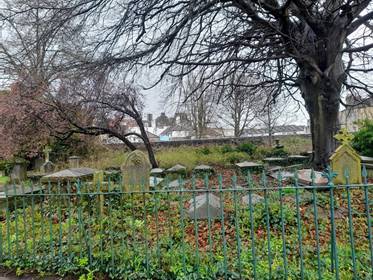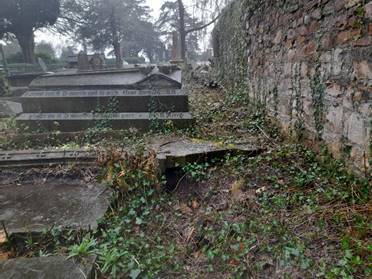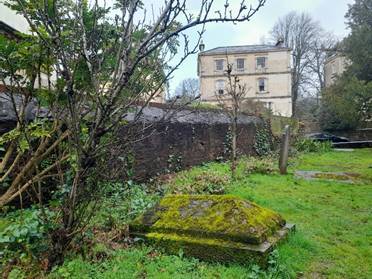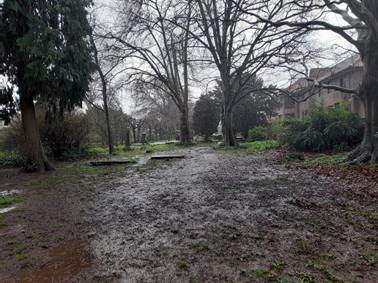Team Wilder, part of Avon Wildlife Trust, offer a professional ecological advice service to help wildlife flourish in our region and create nature-rich neighbourhoods for all to enjoy. https://www.avonwildlifetrust.org.uk/team-wilder-ecological-advisory-service This is a copy of their report on our site.
After a follow up visit in June 2024, further advice was given here.
Contact details
Name: Lesley Woodward
Email: friendsofbirdcagewalk@gmail.com
Site address/grid reference: The cemetery is both sides of the main path running from The Fosseway (BS8 4EN) to Clifton Hill, (BS8 1BN) in Clifton, Bristol.
Grid reference: ST573729
Group/organization: Friends of Birdcage Walk
Date of site visit: 30th March 2023
Outline of the initial query before the site visit
The community group are writing our Management Plan for the site. It is a closed graveyard and is managed by Bristol City Council Parks Dept. The group has undertaken extensive clearance of bramble recently and this has opened up the ground flora. The group need advice on managing and improving the biodiversity of the site.
Size of land
Entire site is 2.7 acres (1.09Ha)
The specific project recommendations relate to 1.7 acres (0.69Ha) of this.
Summary of discussion during the site visit
A number of topics were discussed on site, and this includes:
- How to manage a shaded area that is overgrown with snowberry.
- Different ways in enhancing the bat corridor e.g. through planting night-scented plants.
- Ways to keep the public to the footpaths and away from trampling the vegetation.
- Wildlife features that will benefit wildlife and the community.
- Creating and managing areas of wildflowers.
- Ways to enhance the bank along the western boundary of the site.
Photographs of the site
Photo 1: The shaded area that is overgrown snowberry, facing east.
Photo 2: The western boundary where there is a slight depression in the ground.
Photo 3: The western boundary that is open and receives sunlight.
Photo 4: the bare ground which is trampled by the public and dogs.
Site-specific recommendations from the Team Wilder Community Ecologist
The western bank boundary
- The western bank receives full/partial sunlight as it is very open in some places. I recommend that this bank is sown with a shade tolerant wildflower mix. Ensure that you mow/cut the grassland very short and collect the arisings immediately so that nutrients don’t leach back into the soil (wildflowers grow well in low nutrient soils). Then create at least 50% bare ground by raking or using a hand scarifier. I suggest that you have a look at the wildflower meadow mixes provided from the resources below (Grow Wilder, Habitat Aid, and Emorsgate Seed ) as these offer species mixes for different types of environments. These providers also detail suitable management techniques for the chosen seed mix.
- Additionally, plug plant could be planted into the bank. These could include night-scented plants to attract moths and therefore benefit bats that are using it as a corridor. Please see the resources below for information on different night-scented species.
- There could also be a hibernaculum along the western boundary of the site (e.g. through using the existing depressions in the ground). This can comprise of underground chambers that amphibians and reptiles could use in the winter. A hole can be dug and filled with logs, branches and rocks, making sure to leave plenty of gaps. The hole can then be covered with soil and species could be plug planted or a ‘tussocky’ grass seed mix can be sown on top of the mound. An example is shown here - How to build a hibernaculum for amphibians and reptiles | Wiltshire Wildlife Trust .
- Climber plants, such as honeysuckle, could be planted along the western boundary wall to provide an additional resource for pollinators and also benefit other wildlife such as birds.
The shaded area that is overgrown with snowberry
The snowberry is currently dominating the shaded area and is shading out the ground flora so that limited species can grow. The snowberry can be removed from this area through cutting it back and removing the roots. Once the snowberry has been removed, a shade tolerant seed mix (such as a hedgerow or woodland seed mix) could also be sown between the graves of this area. Another option could be to sow a ‘tussocky’ grass mixture so that there is little bare ground remaining for undesirable species to establish. Plug plants could also be planted within this area (similar to the above comments).
The shaded areas, dominated by bare ground
It is recommended that these areas of bare ground are sown with a ‘tussocky’ grass mixture or a shade tolerant mix as described above. Dead hedges could also be created using any brash or coppice material and these could help encourage the public to keep to more formal paths rather than trample the whole area. This will allow for the scrub and seed mix to establish and grow without being disturbed.
Dead wood piles could also be created within these shaded areas to create additional habitat for wildlife.
Educational signs
Wooden posts could be installed along the paths and by the wildlife features to increase awareness of the different habitats. Holes could be drilled into the sides of the post to act as a bug hotel for species such as mining bees. Other bug hotels can also be created around the site (please see the resources on the Team Wilder webpage, listed below).
Useful resources for the project
Suppliers:
- Grow Wilder: offer native, ethically sourced seeds and wildflowers with a local origin of Bristol. Many of the wildflower seeds have been collected from Avon Wildlife trust reserves.
Available at: Grow Wilder
- Habitat Aid: offer advice on wildlife gardening and habitat creation. The website includes useful resources and there is also a shop where you can purchase native seeds, plants, bulbs and trees as well as tools and accessories can be purchased.
Available at: Habitat Aid | Trees & Hedges | Wildflowers | Meadow Seed
- Emorsgate Seed: offer native wildflower and grass seed mixes as well as advice for individuals and organizations.
Available at: Wildflowers, Wild Grasses and Mixtures | Emorsgate Seeds – (01553) 829 028 (wildseed.co.uk)
Advice for habitat creation:
- Plantlife: useful resources on how to enhance and create habitats
Available at: Plantlife
Specific meadow management available at: Making Meadows
- Magnificent Meadows: advice and guidance on how to create, enhance and manage wildflower meadows for wildlife.
Available at: Magnificent Meadows
- The Wildlife Trusts: advice on how to attract moths and bats to your garden/land.
Available at: How to attract moths and bats to your garden | The Wildlife Trusts
- Amphibians and Reptile Conservation: advice on how to create habitats for amphibians (particularly great crested newts) and reptiles.
Available at: Gardens & ponds | Amphibian and Reptile Conservation (arc-trust.org)
- Wiltshire Wildlife Trust: advice on how to build hibernacula for amphibians and reptiles that can be located nearby ponds.
Available at: How to build a hibernaculum for amphibians and reptiles | Wiltshire Wildlife Trust
- Team Wilder: the Team Wilder webpage has a range of resources available to help you to create habitats for wildlife at home.
Available at: Team Wilder actions for nature at home | Avon Wildlife Trust
Next steps:
I will follow up your project in six months to see how it is going and gather any feedback that you have. You will be contacted closer to the time to arrange this visit.
Proposed follow up visit: September 2023
If you have not done so already, please remember to add your project to the Team Wilder map so that everyone is aware of your amazing ideas/achievements!
Please also share the project’s journey with us and the local community as it is great to learn from each other and share knowledge!
The TWEAS is a pilot project to help create nature-rich neighbourhoods across Avon. We actively encourage feedback on how we could improve this offer. Please email esther.frizell-armitage@avonwildlifetrust.org.uk with your comments.
Signature: Esther Frizell-Armitage
Date: 6th April 2023
Approved on behalf of Bristol Parks by Operational coordinator Central and East, 19 May 2023. To be reviewed October 2023 after follow up visit by Avon Wildlife in September 2023



